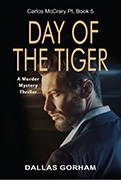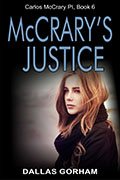Joel Goodman writes a terrific legal thriller
 Final Judgment by Joel Goldman
Final Judgment by Joel Goldman
My rating: 5 of 5 stars
Three plots for the price of one
A fascinating story of coercion, blackmail, and murder. Lou Mason’s heart is in the right place, but sometimes he has to bend the rules to the breaking point. A compromised judge forces Mason to help her clear her name. Then aging con man wants Mason to negotiate a plea bargain. Things get complicated when a headless body turns up. Lou Mason is up to his eyeballs in trouble. You won’t want to put this one down until you finish it. As a mystery/thriller writer myself, I appreciate the skill with which Joel Goldman constructs this enjoyable novel.
I’m appearing at Mystery Mayhem book fair in Bartow, Florida

I’m delighted to be one of the authors appearing at the Bartow Mystery Mayhem Book Fair on Saturday, November 12. I’ll be talking about the business of writing and answering questions about the art and craft of writing. This will also be the first public appearance of my new book McCrary’s Justice.
Is there a gender point of view?
 A couple of days ago I finished the draft of my sixth Carlos McCrary novel McCrary’s Justice. In it, I wrote several chapters from the POV (point of view) of the girlfriend (later fiancé) of Carlos McCrary. Since I have never written from the POV of a woman, I asked several of my writer friends (most of whom were female) to read the chapters and call to my attention any glaring errors.
A couple of days ago I finished the draft of my sixth Carlos McCrary novel McCrary’s Justice. In it, I wrote several chapters from the POV (point of view) of the girlfriend (later fiancé) of Carlos McCrary. Since I have never written from the POV of a woman, I asked several of my writer friends (most of whom were female) to read the chapters and call to my attention any glaring errors.
David Bishop, www.davidbishopbooks.com, sent me what I can only describe as an essay on gender in writing:
“Two things without even reading the pages.
“First, I am not qualified to read and comment on anything from the female POV—I’m male.
“Second, I don’t accept there is any such thing as a female POV. To accept there is, even in theory, implies the acceptance that there is a singular female POV. If there was, it means that each female thinks, decides, and acts in the same manner as all other females. If this is not true, then there is no female POV.
“In my life (my only arena of knowledge) I have found women to have as varied and diverse a POV as do men. We sometimes hear and read (in reviews sometimes) that the author has or has not captured the women’s POV. For me this means, that the individual woman writing that comment finds what she read to be inconsistent with how she individually would act or react to the stimulus that exists in the story. That woman thereby aggrandizes her POV on whatever as the POV of women.
“For me, the relevant question is: Could a woman (not any individual one or even a majority of women) behave in the manner the fictional female character behaves in the story? If the answer is yes, then what the author has that woman character do is plausible. If the answer is no, then the author has written a character who fails in believability–whether that character is female or male.
“My view is: Women are diverse, so don’t get bogged down in the limitation of some fantasy about an overriding women’s POV. Some ladies have sex on the first date, others are nuns. Some ladies scream at a shadow, while others kick the guy in the nuts and slap him silly. Some women work as teachers, while others have sex with their underage students. Others drive a 16-wheeler on the open road rather than wait tables at Denny’s. Some use the “F” word and some don’t. Etc.
“Write your women to be plausible. Could a woman act as your fictional one does? If yes, write it as such. Do that convincingly and most readers, male and female, will accept it. Those who will be critical because they have prescribed for all fictional woman a single POV–which always ends up being their individual POV–well, those folks will be critical of your/my/any author’s POV for females that clash with their own personal POV on whatever subject.
“For further comments, if desired, try female writers or female readers–which might be the better source to begin with. Ask them if they found the behavior of X female in the story to be within the realm of plausible female behavior. Putting it in those terms should let them know you aren’t asking if they endorse that behavior or would behave the same way. The core question is: Can they envision a woman doing whatever your fictional character did?
“I have every one of my stories read by three or four women before I consider them final manuscripts. Their backgrounds are quite different and they do it wonderfully. My stories always benefit from their input.
“Hoped this helped.”
Yes, David, it helped a great deal.
Judi Ciance, author of the Casey Quinby mysteries, was tied up for a couple of weeks. Nevertheless, she took the time to email me back:
“You don’t have to think as a woman per se; think like the character you’re creating. This might be hard, and it might take several rewrites. You remember my Doll Murders. The main character is Detective Mike Mastro. I try to think and act like his character would, to use a voice he and his environment would expect. If that requires edgy language, then so be it. My book isn’t fluff; it’s about a serial murderer, so Detective Mastro isn’t going to be a Casey Quinby type. I suggest you look at some books written by women whose main character(s) are men. But because of the violence you depict, make sure you select an author who writes along the same lines.”
Well said, Judi.
What do you think? Is there a distinct “women’s point of view”?
Novelist risks life because he forgot to backup his work
 Gideon Hodge, a 35-year-old novelist, playwright, and actor, sprinted past New Orleans firefighters into a burning to save his laptop. He had stored two completed novels on the computer. “Anybody that’s ever created art, there’s no replacing that,” he told The New Orleans Advocate after he made it out of the burning building safely. “It’s got pretty much my life’swork.”
Gideon Hodge, a 35-year-old novelist, playwright, and actor, sprinted past New Orleans firefighters into a burning to save his laptop. He had stored two completed novels on the computer. “Anybody that’s ever created art, there’s no replacing that,” he told The New Orleans Advocate after he made it out of the burning building safely. “It’s got pretty much my life’swork.”
While I admire Hodge’s dedication to his work, I wonder about his common sense. No backup?
I use Carbonite, which automatically backs up every working file on my computer every day. It costs $59.99 a year for the basic service–cheap when compared to risking your life.
Does coffee help creativity?
 I remember a scene from an old television show. The Darren McGavin, playing private investigator Mike Hammer, met his client in a coffee shop. He had met her at a coffee shop each time he had something to report. Each time he ordered coffee. Finally, her curiosity got the best of her and she asked, “How much coffee do you drink every day?”
I remember a scene from an old television show. The Darren McGavin, playing private investigator Mike Hammer, met his client in a coffee shop. He had met her at a coffee shop each time he had something to report. Each time he ordered coffee. Finally, her curiosity got the best of her and she asked, “How much coffee do you drink every day?”
He answered, “Fifteen or twenty cups.”
The client said, “Doesn’t it keep you awake?”
Our hero said, “It helps.”
I’m like Honoré de Balzac, the early 19th century French author, who said (translated by Robert Onopa): Coffee is a great power in my life… [It] sets the blood in motion and stimulates the muscles; it… chases away sleep, and gives us the capacity to engage a little longer in the exercise of our intellects.
Balzac is said to have drunk up to 50 cups a day, although his cups were much smaller than today’s mugs. Best-selling author Lee Child reportedly drinks 30 cups a day.
Compared to these writers, my coffee habit is modest. I am usually at my desk by 8:00 a.m., having risen at 5:30, read three newspapers, and breakfasted with my wife. My first cup of breakfast coffee is the normal high-octane stuff to knock the cobwebs off my brain. Years ago a doctor told me after a routine physical that too much caffeine is bad for people, so for the rest of the day I restrict caffeine to times when the cobwebs come back.
After working in my study until about 9:30, I start to feel the cobwebs lurking in the far corners of my mind. Bang! Back to high-octane coffee—only now, I switch to iced coffee. Over the rest of the day, I’ll have three more iced coffees, occasionally four or five.
I discovered iced coffee in 2004 after Hurricane Frances.
11:00 p.m. Saturday, September 4. 2004, Labor Day weekend: Hurricane Frances moved ashore in Martin County, Florida with sustained winds over 100 mph. The eye passed directly over our house, knocking our two-story screened enclosure into our swimming pool. Fortunately, our townhouse was built to the stronger building codes adopted after Hurricane Andrew hit south Florida in 1992. Our home was otherwise intact. Even with underground utilities, our neighborhood electric power was knocked out for four days. (Which is one reason we now live in Lake County, Florida. But that’s another story.) My wife and I had evacuated to Georgia and returned to find our town in need of help.
I am a Volunteer Minister for the Church of Scientology and we worked with the National Guard and the Red Cross to hand out food and water to long lines of victims. The temperature was over 90 degrees in early September with humidity match. Three o’clock in the afternoon, after working in the sun since early morning, I was dissolving into a puddle of sweat and grime. Miraculously, an angel of rescue appeared in the form of a Dunkin’ Donuts panel truck. The Dunkin’ truck pulled into the shopping center parking lot where we were handing out water and ice. The back of the truck was full of huge containers of iced coffee for the volunteers. One sip of that delicious Dunkin’ Donuts iced coffee and I felt like I’d had a two-hour nap in an air-conditioned room. It was almost better than sex. Almost.
Ever since then, I’m a big iced-coffee fan.
What’s in a name? Day of the Tiger
This whole recent kerfuffle about Donald Trump re-tweeting a #Mussolini quote is hogwash. Of course, a lot of the so-called “controversies” the mainstream media create are hogwash, so that’s nothing new.
The quote was supposed to be “It is better to live one day as a lion than a thousand years as a sheep.” I don’t know if Mussolini ever said it or not, but the quotation is a lot older than Mussolini. The original quote is “It is better to live for one day as a tiger that to live for a thousand years as a sheep,” and it is a Tibetan proverb.
I first saw the quotation last year painted on a construction fence at Disney’s Animal Kingdom. The fence surrounded the area where #Disney is building the #Avatar section of the park. I was there with two of my grandchildren and having a wonderful time. I saw the quote and loved it. It sounded so… Disney that I figured the Disney people had created it. It was just too, too perfect to be authentic.
When I got home, I looked it up online and discovered it was a real honest-to-God Tibetan Proverb. The proverb inspired a whole series of “what if…” thoughts that unfolded into the plot of my latest thriller, Day of the Tiger.
I hope you reading Day of the Tiger as much as I enjoyed writing it.
Book Titles Should Send Useful Clues to Readers
It’s been said that you can’t tell a book by its cover. That’s hogwash. (I would have used an earthier expression starting with a B, but this is a family blog.) In the real world of real buyers, most people form their first opinion about a book by its cover. While I enjoy the creative process of writing a book and telling a compelling story, I also try to make a good living doing it. Sales in the marketplace are a good measure of how much people like my work. So I want to sell books—lots of books, thousands of books.
My book covers and titles send important messages to potential buyers who are considering my books. You, the reader, may invest five or ten hours to read a book. Your time has a value, and you’re gambling more than the purchase price when you buy my books.
One of the challenging aspects of marketing any book is to choose a title that people will click on. I want my titles to say, “Yes! That looks interesting. I want to learn more about this book.” My books are only available on the internet. On the internet, people don’t read; they scan. I can’t afford to make you, the buyer, work to figure out the meaning of my title. I have to grab you quickly, or you’ll move on to some other writer.
I want my titles to be short, but I want you to instantly understand what my books are about.
For example, I wrote my first novel using the working title of The Accidental Heiress. Bad idea: Too many friends told me that it sounded like a romance novel. One of my sisters-in-law reads a couple of #romance novels a week. Now I would love to tap into a market that deep and rich, but I prefer to write #mysteries and #thrillers. I went back to the drawing board and brainstormed new titles. I even surveyed a few of my fellow writers and readers (including my sister-in-law).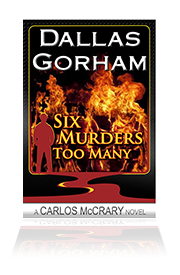 I selected Six Murders Too Many. That tells the reader that this is a #mystery. It also says that it has lots of action. And the cover design with the burning house is a real attention-grabber. If I had gone with my original title, it would probably have been a dud seller.
I selected Six Murders Too Many. That tells the reader that this is a #mystery. It also says that it has lots of action. And the cover design with the burning house is a real attention-grabber. If I had gone with my original title, it would probably have been a dud seller.
My second novel, Double Fake, Double Murder 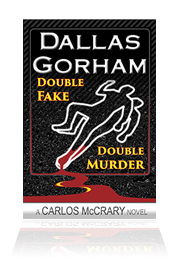 was originally going to be titled just Double Fake. A title search on Amazon revealed that there were two other books with “double fake” in the title. They were both about soccer. So I added “double murder” to the title. Now anybody can tell that this is a mystery, not a soccer guide. And I love the double outline of two bodies on the cover. Mike Butler, my cover designer, came up with that one. Great idea, Mike!
was originally going to be titled just Double Fake. A title search on Amazon revealed that there were two other books with “double fake” in the title. They were both about soccer. So I added “double murder” to the title. Now anybody can tell that this is a mystery, not a soccer guide. And I love the double outline of two bodies on the cover. Mike Butler, my cover designer, came up with that one. Great idea, Mike!
Quarterback Trap, the third Carlos McCrary novel, was so obvious that the title almost selected itself.  The star quarterback of the upcoming Super Bowl game has his fiancée kidnapped by mobsters who have a huge bet on the game. The star quarterback felt trapped. Duh… The title was a piece of cake. And the cover of a gun over-shadowing a football stadium tells a great story by itself.
The star quarterback of the upcoming Super Bowl game has his fiancée kidnapped by mobsters who have a huge bet on the game. The star quarterback felt trapped. Duh… The title was a piece of cake. And the cover of a gun over-shadowing a football stadium tells a great story by itself.
Dangerous Friends was a tough choice.  I’m still not crazy about the title, but at least the word “danger” tells the buyer that this is a #thriller. The “dangerous friends” are eco-terrorists that dupe an idealistic college student into committing a #terrorist act. If you think of better title, let me know. The cover image shows a key scene from early in the book that starts the whole thriller on its whirlwind roller-coaster ride to the finish.
I’m still not crazy about the title, but at least the word “danger” tells the buyer that this is a #thriller. The “dangerous friends” are eco-terrorists that dupe an idealistic college student into committing a #terrorist act. If you think of better title, let me know. The cover image shows a key scene from early in the book that starts the whole thriller on its whirlwind roller-coaster ride to the finish.
In my next blog I’ll cover my latest book, Day of the Tiger.
Inside the black tent (where the magic happens)
I just sent my fifth novel Day of the Tiger to the editor.
I had been chained to my desk, pounding my keyboard until my fingernails bled, for virtually the entire month of January in order to finish the manuscript by the January 31 deadline. This outrageously tight deadline was impo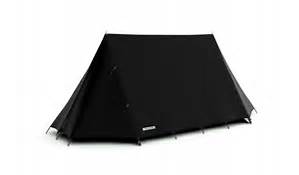 sed by the harshest taskmaster I’ve ever slaved under–me. I unlocked the door to my office (where all the magic happens) only when I emerged for another #caffeine fix or the occasional crust of stale bread with crunchy peanut butter and raspberry-jalapeno jelly. Then I would tell myself, “Eat fast, then get back to work.” I pounded out between 2,000 and 4,000 words most days, working from about 8:00 a.m. to 6:00 p.m.
sed by the harshest taskmaster I’ve ever slaved under–me. I unlocked the door to my office (where all the magic happens) only when I emerged for another #caffeine fix or the occasional crust of stale bread with crunchy peanut butter and raspberry-jalapeno jelly. Then I would tell myself, “Eat fast, then get back to work.” I pounded out between 2,000 and 4,000 words most days, working from about 8:00 a.m. to 6:00 p.m.
Should be available in March. Egad! That’s next month!
I write for three reasons: First, it’s a lot of fun to create an entire world with people, buildings, climate, cities, politics and so forth, all from my own goofball mind. Second, I like to make the world a better place by giving people something entertaining and uplifting. A place where the good guys win, right triumphs, and the bad guys get what’s coming to them. Ah, if only the world were really that way all the time. Third, I hope to make a pot full of money from my writing.
People often ask where I get my ideas.Some people think that a successful #writer comes up with a good idea, then goes into a black tent, does some magic, and emerges later with a well-crafted, entertaining book for them to read.
Creating the idea is the easy part.
If all it took to write a good book was to have a good idea, then anybody could do it. That’s like saying “Anyone with a set of #golf clubs can play on the #PGA or #LPGA Tour.” It is true that anyone can play golf. In fact, I played nine holes earlier this week. But not just anyone can play golf well. There are a gazillion duffers like me. We hack around from rough to bunker to lake and eventually get the little white ball (or in my case, the little optic yellow ball) in the hole. But there are precious few players like my fellow Texas Longhorn Jordan Spieth. These men and women look at par in their rear-view mirror while they blaze their way around the course with the skills to make it look oh, so, easy. Anyone who’s ever played golf knows that it’s a lot harder than it looks.
Writing is the same as playing golf. Anyone with a computer and an internet connection can write and publish a book. And hundreds of thousands of people have done so. It doesn’t even cost anything. So it’s true that anyone and everyone can write. But to write well… Ah, that’s another thing.
Having a good idea for a plot is about ten percent of what’s needed to write a good book. The other ninety percent is to tell that story in a way that entertains the reader and keeps him or her wanting to read more books by the talented author. Think of Robert B. Parker, Robert A. Heinlein, Mickey Spillane, Agatha Christie, and John D. MacDonald of the fiction world. And those are just a few of the great, but unfortunately dead, writers whom I admire. I didn’t mention any living authors because I have so many favorites and I wouldn’t want to inadvertently leave anyone out. Thousands of raving fans would buy and read everything these fiction giants wrote. I hope someday I can earn half the fan loyalty these men and women earned.
Inside the black tent
I’m going to lift the wall of the black tent and show you how I made the magic happen with my most recent attempt at literary immortality, The Day of the Tiger.
My first draft followed the principal of “Dump it on the page and get the basics of the story right.” I met a fellow writer who wore a tee-shirt that said, “I don’t care if it’s crap; just get it on the page.” That’s my motto because you can’t improve a story that’s not written. Until you have a completed story, you don’t have a product–not even a bad product. Some famous writer whose name escapes me once said, “Every good novel began as a lousy first draft.”
In this case, my lousy first draft ran 77,787 words. That took about four solid weeks chained to my desk.
I finished the first draft, patted myself on the back, admired this work of genius for about three seconds, then plunged into the second draft.
To write the second draft, I read the first draft aloud to see how the words sounded. I know that you don’t move your lips when you read. But even when you read silently, you hear in your mind how the words sound. I want my words to sound well in the reader’s head. I read the first draft aloud and stopped when something didn’t flow just right. I made the changes to the draft and kept reading. That took two days to read, change, and create the second draft.
The second draft ran 79,809 words. That means that I had to add about 2,000 more words to make the words flow smoothly.
And, yes, I did get hoarse reading aloud for over twelve hours.
To write the third draft, I ran the second draft through a piece of software called Smart Edit, available from Bad Wolf Software. Smart Edit is the best fifty bucks I ever spent, if you don’t count the money I spent on my first date with the woman who is now my wife. Smart Edit looks for things like overused adverbs, repeated phrases, misused words (such as their when you mean there), clichés, redundancies, proper nouns (to make sure I don’t call a character Monty one time and Marty the rest of the time), and so forth. One real-life catch: There is one setting where my fearless hero Carlos McCrary drops off the ransom for the kidnapping victim. In one chapter I called it “Fisherman’s Pier” and in another chapter I called it “Fishermen’s Pier.” You might think that’s a nit-picky difference, but excellence in writing is a game of inches.And if you were the reader who noticed the inconsistency, it could affect your opinion of the quality of my work overall. Perish the thought.
The third draft had 78,626 words and took another two days.
The fourth draft was a bitch. It took just over a week to go through my “List of words to restrict use of.” It’s a list of over fifty words or parts of words that writers sometimes overuse: about, almost, also, anyway, can or could, get, going or going to, etc. See my blog of How to be a better writer–words to avoid. That original list had only 41 items on it. Now I have over fifty.
That draft wound up with 74,216words.
Then I print the fourth draft, sit in my easy chair, and read it just like you would (except I have a ballpoint pen in my hand). That was 211 pages of 8-1/2 by 11 paper. I discovered some parts in an earlier chapter that I moved to a later chapter where the flow of the action made more sense. Those corrections took another two days and resulted in the fifth draft, which had 74,166 words.
That’s the one I sent to my #editor.
A word or two about my editor, Marsha Butler: Marsha makes me a better writer. Yes, she does line edits like any other editor, but that’s not all. She also reads the book. She has opinions on what works, what doesn’t, and how to make my manuscript better. Every writer should be lucky enough to find an editor like Marsha. Her website is butlerink.com. Check it out.
It’s not magic after all
So it’s not just getting a good idea and waving a magic wand. It’s hard work, sweat, pacing the floor, taking a break to let my mind unclench, and a lot more. Yes, my mind clenches after a few hours of uninterrupted writing. Thank goodness for lunch and coffee breaks.
Why James Patterson is one of the top-selling authors in the world
I just finished reading Invisible by James Patterson and David Ellis. Wow! What a ride.
One thing that made Invisible so special was that my copy was a gift from James Patterson himself. Now I can’t get a big head over this because Mr. Patterson also gave copies to about 300 of my fellow members of Mystery Writers of America who attended Sleuthfest 2015, the annual convention of the MWA, last February. Patterson was scheduled to give the keynote address. At the last minute, he had a family emergency which required him to cancel. So he sent 300 copies of his latest book to those of us who missed him, along with a letter which said, in part, “Your support means the world to me, and I would be thrilled to say thank you in person one day soon. Until then, I hope you’ll accept this book, Invisible, as a small token of my apology. Yours, J. Patterson”
Now, that’s a class act. Anyway, on to the book.
The opening paragraph grabbed me. “This time I know it. I know it with a certainty that chokes my throat with panic, that grips and twists my heart until it’s ripped from its mooring. This time, I’m too late.” Then, Invisible goes on for 397 more pages of murders, clues, mysteries, and thrills, culminating with an edge-of-your-seat climax and an “Ohmigawd!” plot twist at the very end.
The story is told in first person by Emmy Dockery, who took leave from her job as an FBI researcher to solve her own sister’s murder. The only problem is that the authorities insist that her sister’s death by fire was an accident.
One of the many things I enjoyed about the book is the feminine voice of the narrator. Patterson and Ellis did a great job of writing from a woman’s point of view. From the catty remarks about another woman Emmy was jealous of, to describing her break-up with another of the main characters, I felt like a woman was narrating. My own books are written from the viewpoint of a male private investigator and former Special Forces soldier. I don’t think I could write from a woman’s viewpoint like that. But Patterson and Ellis succeed. Maybe that’s one reason Patterson has sold over 280 million books.
About three chapters into the book I noticed another subtle feature that I hadn’t seen before—Invisible is written in the present tense. Emmy Dockery’s narration occurs as she studies the evidence, investigates the clues, and interacts with the other characters. The present tense gives the immediacy of solving the mystery alongside the heroine. Take this pivotal scene where Emmy proves that the fire was no accident:
Lia Janus [FBI forensic pathologist] looks around the room and releases a heavy sigh…
“I’ve conducted more than a thousand autopsies…,” she says. “I’ve… seen everything, guys. It’s impossible to surprise me.”
And? And?
“After examining the bodies of [two other victims], you can put me down as surprised,” she says.
I won’t give you the rest, because I don’t want to spoil the story.
Patterson and Ellis have another big winner in Invisible.
Use powerful verbs and descriptive nouns

Every experienced writer has heard the advice to use action verbs. This also includes the advice to avoid adverbs and adjective. Instead, choose verbs and nouns that are more descriptive by themselves. For example, don’t say “She walked proudly down the street.” Say “She strutted down the street.” Don’t say, “He opened the car door quickly.” Say “He jerked the car door open.”
Most best-selling authors are masters of the action verb and the descriptive noun.
Take Lee Child for instance. Here’s an example of his from Chapter 33 of Die Trying, the second Jack Reacher novel: “The air force Bell put down on a gravel turnout two hundred yards south of where the road into Yorke narrowed and straightened into the hills. [emphasis supplied.]”
Mr. Childs could have said: “The air force helicopter landed on a gravel turnout two hundred yards south of where the road into Yorke dropped to two lanes and turned into the hills.”
But Child used more expressive verbs.
Here’s another example from the same chapter: “A random pattern of military vehicles slewed across the blacktop. [emphasis supplied.]” He could have said: “A random pattern of military vehicles sped across the blacktop.” But
Child used the more expressive “slewed.”
Another: “An officer slid out… saluted the General and skipped around to open all the doors. The five men squeezed in and the car turned again and rolled the two hundred yards north to the mess of vehicles.” Another writer might have said, “An officer got out… saluted the General and hurried to open all the doors. The five men got in and the car turned again and drove the two hundred yards north to the mess of vehicles.”
And note Child’s choice of “mess” for the grouping of vehicles. Even nouns can be made more descriptive without adding an adjective.
Small, insignificant differences? Small, yes. Insignificant, no. Small differences can turn a pretty good story into an excellent one.
Here’s an example from chapter 8 of Invisible, by James Patterson and David Ellis: “I pop awake, gasping for air, the dancing flames on the ceiling receding to a dark, quiet room. [emphasis supplied.]” The protagonist didn’t “wake suddenly”; she “popped.”
A good writer can even draft a noun like “bucket” and convert it to a verb. An example from chapter 1 of The Escape, by David Baldacci: “When the two rampaging fronts met…, the result was a storm of shattering proportions, with jagged lightning slicing sideways…, rain bucketing down….” I loved the use of “slicing” to describe the lightning.
Here’s how I used these principles in my third Carlos McCrary novel, Quarterback Trap:
Old: A green Mercedes approached the main garage exit.
Improved: A green Mercedes rolled to a stop at the garage exit.
Old: We waited until the last of the cars had driven off the ferry.
Improved: We waited until the last of the cars had bumped off the ferry.
Old: I started the engines, then called Flamer while they warmed up.
Improved: I cranked the engines, then called Flamer while they warmed up.
Old: The B-r-r-r-rap of automatic weapon fire came from the sun deck.
Improved: The B-r-r-r-rap of automatic weapon fire ripped from the sun deck.
Old: I closed the door behind the two Port City detectives….
Improved: I bolted the door behind the two Port City detectives….
Old: I picked up Pisarczik’s AK-47…. Improved: I grabbed Pisarczik’s AK-47….
Even staid, ordinary nouns can be punched up.
Old: The sound of Bob opening his bedroom door woke me.
Improved: The click of Bob opening his bedroom door woke me.
“Click” is more descriptive than “sound.” Exciting, expressive verbs and descriptive nouns add that extra oomph to writing.






